2. Physics of Light ( فيزياء الضوء )
Optometry (البصريات )

About 2. Physics of Light ( فيزياء الضوء )
The Physics of Light course delves into the fundamental properties and behaviors of light. Here are some key topics typically covered:
- Electromagnetic Theory: Understanding light as an electromagnetic wave.
- Wave-Particle Duality: Exploring the dual nature of light.
- Reflection and Refraction: Principles governing the behavior of light at interfaces.
- Interference and Diffraction: Phenomena resulting from the wave nature of light.
- Polarization: Study of light waves’ orientation and its applications.
- Optical Instruments: Design and function of devices like microscopes and telescopes.
- Quantum Optics: Basics of light interaction at the quantum level.
- Spectroscopy: Techniques for analyzing light spectra to understand material properties.
تتناول مادة فيزياء الضوء الخصائص والسلوكيات الأساسية للضوء. وفيما يلي بعض الموضوعات الرئيسية التي يتم تغطيتها عادةً:
- نظرية الكهرومغناطيسية: فهم الضوء كموجة كهرومغناطيسية.
- ثنائية الموجة والجسيم: استكشاف الطبيعة المزدوجة للضوء.
- الانعكاس والانكسار: المبادئ التي تحكم سلوك الضوء عند الواجهات.
- التداخل والحيود: الظواهر الناتجة عن الطبيعة الموجية للضوء.
- الاستقطاب: دراسة اتجاه موجات الضوء وتطبيقاتها.
- الأجهزة البصرية: تصميم ووظيفة الأجهزة مثل المجاهر والتلسكوبات.
- البصريات الكمومية: أساسيات تفاعل الضوء على المستوى الكمومي.
- التحليل الطيفي: تقنيات تحليل أطياف الضوء لفهم خصائص المواد.
Program Learning outcome:
By the end of the course, students should be able to:
1. Describe the electromagnetic nature of light and its implications.
2. Apply wave and particle models to explain light behavior.
3. Analyze optical phenomena such as reflection, refraction, interference, and diffraction.
4. Understand and utilize polarization in various applications.
5. Design and evaluate optical instruments for practical use.
6. Explain quantum optical effects and their significance.
7. Use spectroscopy techniques to investigate material properties.
بعد دراسة المادة، يجب أن يكون الطلاب قادرين على:
1. وصف الطبيعة الكهرومغناطيسية للضوء وتداعياتها.
2. تطبيق نماذج الموجات والجسيمات لشرح سلوك الضوء.
3. تحليل الظواهر البصرية مثل الانعكاس والانكسار والتداخل والحيود.
4. فهم الاستقطاب والاستفادة منه في تطبيقات مختلفة.
5. تصميم وتقييم الأدوات البصرية للاستخدام العملي.
6. شرح التأثيرات البصرية الكمومية وأهميتها.
7. استخدام تقنيات التحليل الطيفي للتحقيق في خصائص المواد.

TextBook Name:
Introduction to Light by Gary Waldman